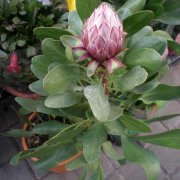Care of the shrub Protea obtusifolia or Limestone sugarbush |
|
The genus Protea, family Proteaceae, includes about 80 species of shrubs and trees native to eastern and southern Africa. Some species are: Protea obtusifolia, Protea cynaroides, Protea eximia, Protea caffra, Protea aristata, Protea laurifolia, Protea barbigera, Protea cryophila. Common name: Limestone sugarbush. This species is native to the Cape Provinces of South Africa. They are large evergreen shrubs with a wide crown that reach 4 meters (13.12 feet) in height and 5 meters (16.4 feet) in width. The dark green leathery leaves are oblong-lanceolate in shape and up to 15 cm (5.9") in length. The large inflorescences are up to 12 cm in diameter and have showy pink, white or red bracts. They bloom in spring and summer. They produce walnut-shaped fruits. Limestone sugarbush is used to form informal hedges, in bushy groups, as isolated specimens, in large pots for patios and terraces, and as cut flowers. It's ideal for Mediterranean coastal gardens due to its resistance to salinity. Protea obtusifolia needs direct sun exposure and a Mediterranean climate. It does not resist frost. Limestone sugarbush grows in clay, poor, rocky, sandy or alkaline soils. Protea obtusifolia is a very resistant to drought plant that needs moderate watering throughout the year waiting for the substrate to have dried completely. Fertilize with leaf mulch in early spring. Prune wilted inflorescences and dry branches. Protea obtusifolia is a plant resistant to the usual pests and diseases. Limestone sugarbush is propagated from seeds sown in the fall in the seedbed (they germinate in 30 days) and by means of semi-woody cuttings in spring or autumn. |
Images of the shrub Protea obtusifolia or Limestone sugarbush |
Find plants
Protea obtusifolia or Limestone sugarbush | Care and Growing
© 2025 FavThemes


